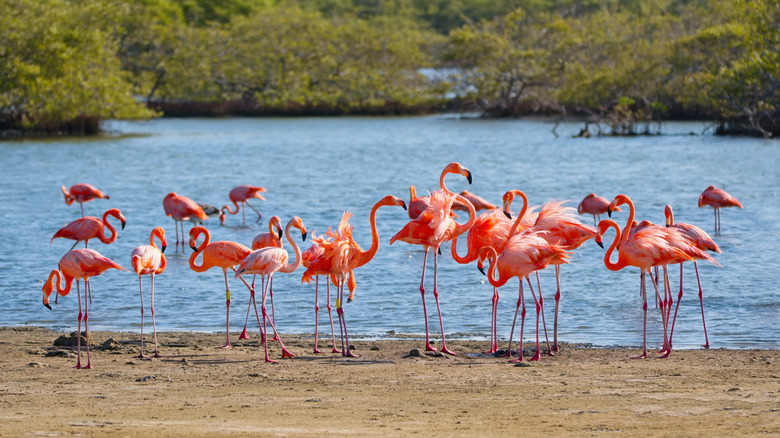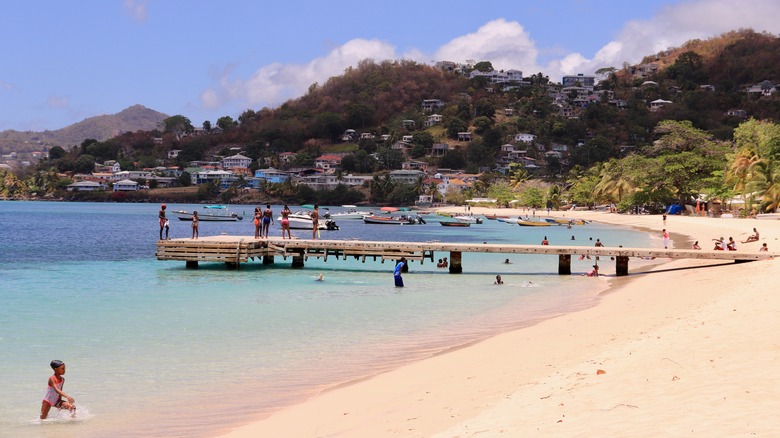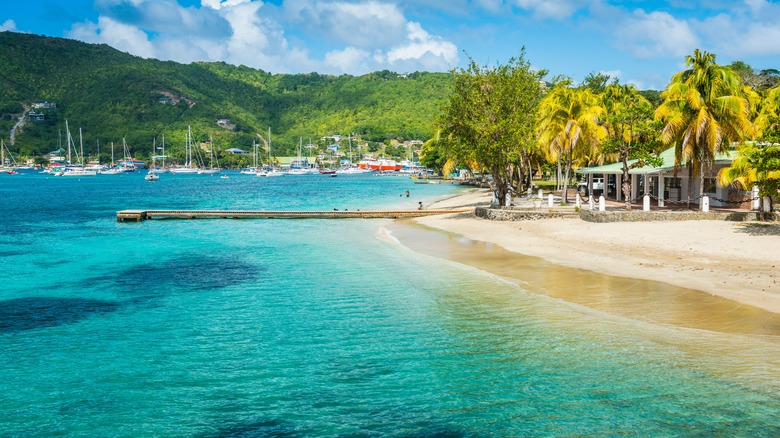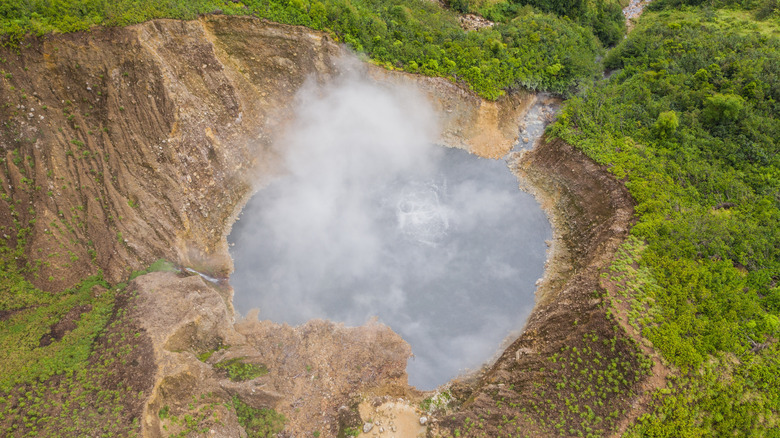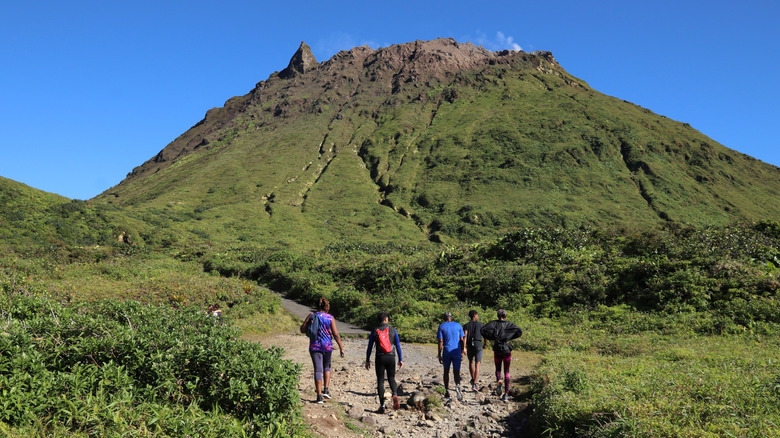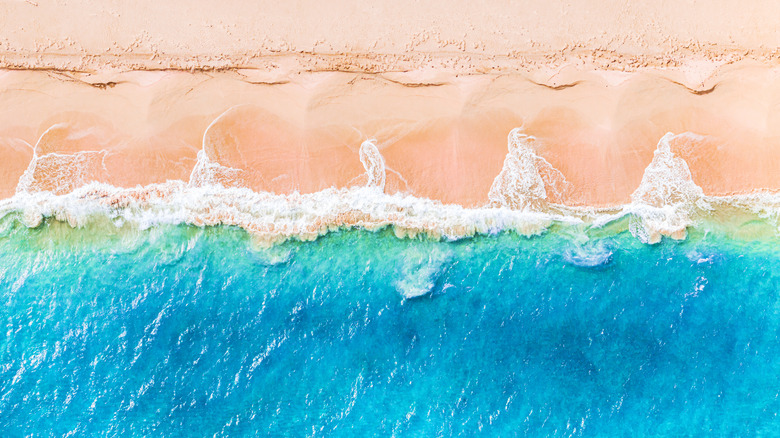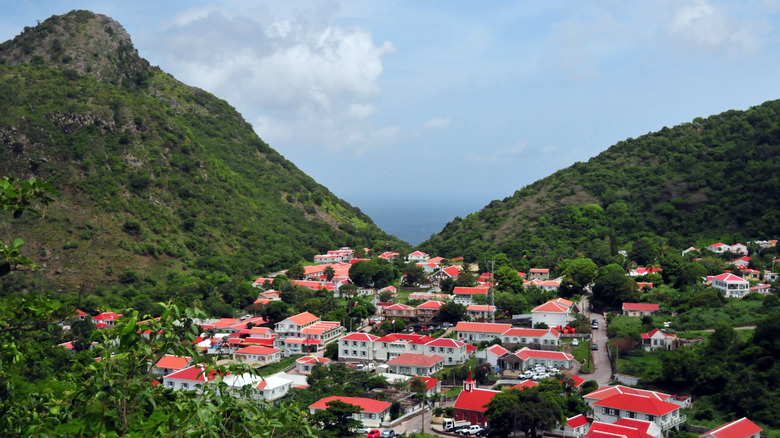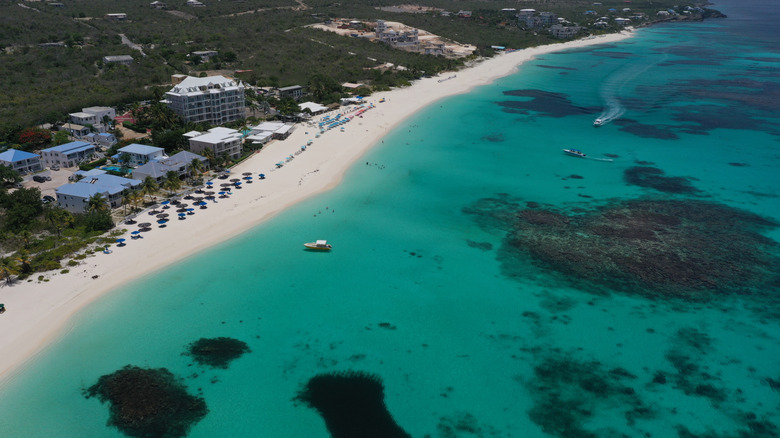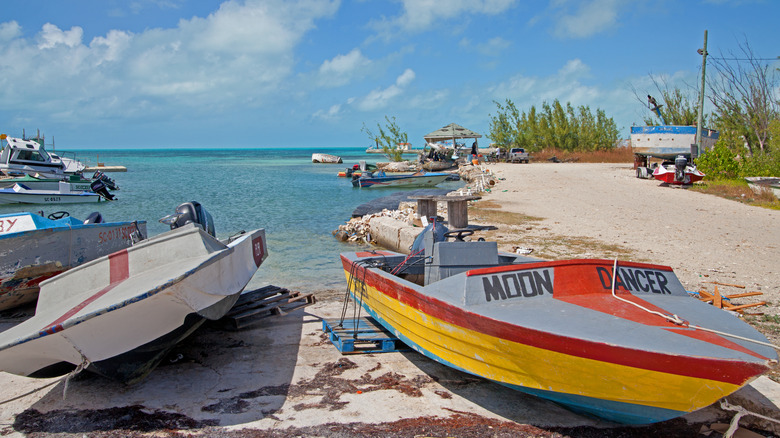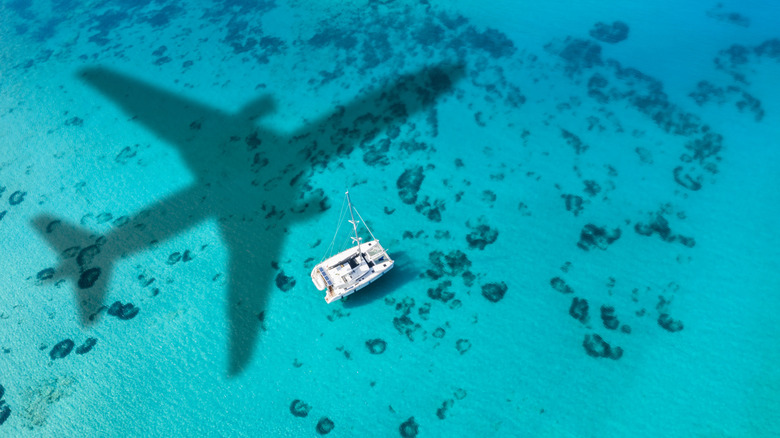These Are The 10 Most Underrated Caribbean Islands, According To Travelers
When people dream of an idyllic trip to the Caribbean, they often think about following the hordes to places like Aruba, the Bahamas, or maybe even Jamaica or Barbados. Which is fine. These are beautiful spots and popular for a reason. But there is a treasure trove of genuinely stunning islands in the Caribbean Sea that most people don't bother with. They might not have the cruise ship docks or massive resorts where you never need to leave the compound, but they do offer things like character-filled fishing ports, sublime hiking, beaches where you might never see another soul, and heartfelt invitations to home-cooked meals.
On these islands, you can expect people to be genuinely curious about you instead of trying to sell you a timeshare or a box-checking excursion. And the bottom line is, if you visit any of these underrated Caribbean gems, real local culture, natural wonders, and prices that work for everyone are just the beginning of what awaits you. So, pack sensibly, keep a flexible itinerary, and prepare to slow down because you might just get what those Caribbean brochures always promise but infrequently deliver.
Curaçao
You'll find the criminally underrated island of Curaçao just off the north coast of Venezuela. It's the C in the ABC Islands, and its capital, Willemstad, is a riot of color, with its pastel Dutch buildings vividly reflecting off the deep blue waters of St. Anna Bay. Outside the capital, the character is more rugged. Cacti dot limestone hills, and the coastline hides coves with soft white sand and turquoise waters. Nearby Aruba might chase the cruise crowds and offer luxury beachfront resorts, but in Curaçao, the vibe is less commercialized, and best of all, year-round sunshine means near-perfect weather every day.
The island blends numerous influences, including African and Indigenous cultures, as well as European influences brought by the Dutch, Spanish, and Portuguese — and they are all openly celebrated together in a smorgasbord of food, architecture, and festivals. The UNESCO-listed historic center at Willemstad, the Afro-Creole living museum at Kas di Pal'i Maishi, and the Punda Vibes street party in the district of Punda are just a few ways you can witness culture taking center stage.
But it isn't all about this marvelous mishmash. There are more than 60 shore-accessible snorkel and dive sites, including house reefs just a short swim from the sand. Then there's the sponge-covered wreck at Tugboat Beach, with its swarms of fish and accessible shallow waters, while the Superior Producer is another must-dive Caribbean shipwreck. You also get the sea turtle hotspot of Playa Grandi and the technicolor coral adventures at Klein Curaçao. In a generally positive Tripadvisor discussion, one traveler explained why anyone should go to the island with a list of reasons, which included "the fact that the prime income of Curaçao is not tourism" and "there is lots to do (apart from beaches)."
Bonaire
Bonaire is the 'B' in the ABC Islands, and it's just a stone's throw from its 'C' sibling, just off the coast of Venezuela. Like Curaçao, Bonaire is another Dutch special municipality in the Caribbean. But both live in the shadow of the ever-popular Aruba. The big question, however, is why? The island has reliable year-round sunshine, and there is no hurricane season to speak of. Downtown Kralendijk, the capital, features Dutch-style buildings painted brightly in classic Caribbean style with teal, pink, lemon, and coral facades that feel straight out of a storybook. The city is walkable, and you won't tire of exploring the waterfront cafés, boutiques, and historic sites, while beach bars and seaside eateries are excellent places to spend the afternoon next to the Caribbean Sea.
Away from the city, the island's terrain ranges from green hills in the north to salt flats, lagoons, and flamingo-inhabited wetlands in the south. It's absolutely a place for nature lovers, and it proudly holds the distinction of being the world's first "Blue Destination," which is recognition for exceptional sustainable tourism and marine conservation efforts. Uniquely, it is the only country in the world to be completely surrounded by a protected marine park — and that means incredible underwater worlds.
Bonaire is one of the best islands for snorkeling on the planet, and known as the shore-diving capital of the world, with 54 of its 86 spots all accessible right from the sand. There's also the shipwreck site of the infamous Hilma Hooker, while the island offers plenty of other activities for nature addicts. These include hiking in the Washington Slagbaai National Park, cliff jumping, windsurfing, or even blokart landsailing for a three-wheeled, sail-powered go-kart experience.
Grenada
Grenada is actually three islands. There's the main island of Grenada plus the even-less-visited Carriacou and Petite Martinique. The country sits at the southern end of a curve known as the Windward Islands that separates the Caribbean Sea from the Atlantic Ocean and is nicknamed the "Spice Isle." Grenada offers travelers an aromatic adventure, with ginger, cloves, and other spices sold everywhere or drying in the sun. Even the local ice cream is a unique nutmeg flavor.
There's plenty to see and do, too. There are old forts steeped in history, stunning waterfalls, wide coastal views, and a national park with trekking trails and a crater lake. Then there are the beaches. With its golden sand and turquoise water, Grand Anse is the highlight. But there are other gems, including Menere Point, Gaby's Beach, and the wonderfully named Pink Gin Beach. They all offer quiet seclusion, but for something a little more dramatic, Grenada has more than 50 excellent dive locations, including the Bianca C wreck, a.k.a. the "Titanic of the Caribbean."
And while temperatures are pleasant year-round, visit in the dry season (January to May) for optimal conditions and comfort. Avoid the hurricane season, especially September and October (Carriacou and Petite Martinique are still recovering from 2024's Hurricane Beryl), and if you want to enjoy the popular Spicemas festival, it takes over in August and peaks with dazzling street parades of light, color, and a stirring soca soundtrack.
Bequia
Bequia is another hidden Caribbean gem. It's part of Saint Vincent and the Grenadines, and at just 7 square miles, it's an underrated speck. It lies just slightly to the northeast of Grenada, but you can reach it by ferry or plane from St. Vincent. With no cruise ships, big-name hotels, or even a decent taxi service, there's nothing sophisticated about its infrastructure. But for those who make it, the underdevelopment is pretty much the reason why they keep coming back. The place is so unused to visitors that locals still wave and stop to chat with travelers on the street. Boatmakers build fishing boats on the beach, just as their grandfathers did, and the harbor at Port Elizabeth is lined with them. You can sit and watch all day from the easy-going bars there if you like, but there are plenty of other things to do.
Crystalline waters at Princess Margaret Beach and Lower Bay attract snorkelers, as do the nearby reefs and wrecks. Trips to the outlying islands are also popular, while a community known as Moonhole offers unusual stone houses built into the seaside cliffs. It was an eco-minded project that started in the '60s, and if you seek solitude, a few houses may be available to rent. Other popular attractions include a sweaty hike up Mount Peggy for some worthwhile views and browsing the markets for genuine handcrafted souvenirs that actually have personality.
Dominica
Dominica sits wedged between Guadeloupe and Martinique in the eastern Caribbean, about halfway up the Windward Islands curve. Most people fly right over it without even giving it a second thought, and given that there are very few direct flights from the U.S. (Miami has one), and it has roads that feel like they were last maintained sometime in the '70s, you begin to understand why Dominica stays off most people's radars. There aren't many beaches, either, and the ones that are there, like Batibou and Mero, are more about quiet sunsets than Instagram shots. So, if it's beachside resorts and poolside cocktails you want, book somewhere else. Dominica doesn't have any of that.
What it does have is nature. In fact, it's nicknamed "Nature Island" in case you forget. It's basically one giant volcanic mountain covered in rainforest, with rivers and waterfalls tumbling down just about everywhere you look. Cascades like Trafalgar Falls and Emerald Pool are well worth the trek if you can handle the humidity and don't mind getting properly muddy. But the main attraction is hiking six hours through trails with volcanic vents and steaming geysers to reach Boiling Lake, which is exactly what it sounds like — it'll cook you if you fall in.
Then there's Titou Gorge, a very narrow canyon that you can drift down to a hidden waterfall tucked inside a jungle cave. You can snorkel at Champagne Reef, where you'll experience warm volcanic bubbles rising from the seafloor like you're in a glass of bubbly, while giant sperm whales cruise the waters all year. In fact, Dominica is the only place on Earth where you can count on seeing this species year-round.
Guadeloupe
The French overseas department of Guadeloupe is shaped like a butterfly with wings formed by Basse-Terre and Grande-Terre. It's sandwiched between Dominica to the south and Antigua and Barbuda to the north, and it's pretty rare for North Americans to visit. While there are direct flights from Miami and New York, it is mostly French tourists who show up.
Everything is in French, and everyone assumes you know what a croque monsieur is. There are croissants for breakfast and full French menus, and with the ubiquitous zouk music and Creole also widely spoken, it's not your typical Caribbean experience. One Redditor underscored the language barrier when they said, "Guadeloupe is a hidden gem!!! ... Though, it's not touristy so do get some simple French under your belt." A commenter on Tripadvisor agreed, "It will likely be one of the least 'touristy' places you've traveled to. No high rise hotels, pretty much no all inclusive type 'resorts.'"
So, if you're interested in an authentic slice of French-Caribbean culture without the usual tourist circus, Guadeloupe is the place to go. Basse-Terre is the wild, mountainous side with Parc National de la Guadeloupe and La Soufrière volcano if you want to do some serious hiking. Grande-Terre is flatter and has some impressive white-sand beaches and low-key resort areas. But, for an under-the-radar series of breathtaking islands, the real gem is Les Saintes to the south. You'll discover world-class bays and dive spots, while even snorkelers can find sea turtles, thriving coral, and diverse species of tropical fish.
Barbuda
Barbuda is the quieter, less-visited half of Antigua and Barbuda. It sits directly north of its sibling just as the Windward Islands start veering west toward Puerto Rico. The main road on the island is rough, and half the paths that lead to Barbuda's best spots aren't marked, but when you're exploring an island that hasn't been packaged for mass tourism, it comes with the territory. Barbuda is home to around 1,500 people, most of whom reside in the village of Codrington, and the whole place is run on genuine hospitality through family guesthouses and small eco-lodges. However, there has been a recent construction boom along the south coast that has locals concerned about development, which tells you everything you need to know about how pristine this place is.
The island's major selling point is an 11-mile stretch of pink sand that cuts between the sea and Codrington Lagoon. It's named either 11- or 17-Mile Beach, depending on your source, but whichever you go with, it's one of the longest unbroken stretches in the Caribbean, and you might even have it all to yourself. The cotton candy-colored sand against the turquoise ocean is indescribable, but one Google Maps reviewer did put it nicely with, "If Antigua and Barbuda is paradise on Earth, then this beach is paradise within paradise." If you visit, be aware there are no amenities or shade, so go prepared.
At the northern end of the lagoon, you'll find the island's other major attraction, the Frigate Bird Sanctuary. It's one of the world's largest frigate bird colonies. Local guides will boat you through during the mating season when males inflate their brilliant red throat pouches and put on incredible displays.
Saba
The tiny island of Saba covers just 5 square miles and offers something a little different. Due to its minuscule size, this Dutch special municipality receives no large cruise ships, and there are no beaches, either. That means no gaggles of camera-wielding tourists, and if you make the effort to go, you'll literally be one of the few foreigners there. In fact, there are only 124 rooms in total, so it's essential to book ahead if you want to be one of the chosen few. You'll also need to brave the world's shortest commercial runway on arrival, which is another reason why Saba is so overlooked. That and the fact that most people have never heard of it.
If it's all-inclusive resorts, theme parks, and casinos you desire, go to Aruba. Saba has none of that. It's known as the "Unspoiled Queen" and focuses on ecotourism and relaxation rather than water sports and parties. Solar panels provide daytime power, and the island relies entirely on rainwater collection. With such a focus on nature, it's hardly surprising that it's a paradise for scuba divers. Visibility is near perfect, and minimal crowds mean you'll have the water pretty much to yourself, unless you include the turtles, stingrays, and eels that you'll have for company.
Hikers can take on Mount Scenery. At 2,877 feet, you'll be at the tip of the volcano from which the island was formed. At the bottom, you'll find the aptly named capital, The Bottom. The rest of the island's residents live in small, scattered villages, but there's just one road on the entire landmass. This single, winding thoroughfare that connects all the communities is known simply as "The Road," and it will treat you to one of the most scenic drives of your life.
Anguilla
To the north of Saba, you'll find a long, thin sliver known as Anguilla. You'll love this place if it's natural beaches, fresh seafood, low visitor numbers, and genuine local authenticity you seek. There are no all-inclusive resorts, zero casinos, a complete absence of big cruise ships, and even a lack of jet skis. If you come to Anguilla, you get just that — Anguilla. It deliberately avoids mass tourism, and with the cruise ship crowds and chaos notably absent, coupled with hard-to-find direct flights and the need for a touch more spending money, the island is often overlooked. But it's a status the locals are more than happy with.
For intrepid travelers, the extra effort and costs are very much worth it, especially if you're a foodie. You can eat your heart out on the island's signature dishes, like crayfish ceviche, stewed goat, or even lobster mac and cheese. One Redditor claimed that "Anguilla has the best food I have ever eaten," while another mentioned it's "known as the C Culinary Capital of the Caribbean , and there's everything from beachside BBQ spots to high-end dining."
As far as beaches go, Meads Bay blends stunning views with restaurants perched right on the water's edge, but Shoal Bay grabs most of the attention with its jewel-toned waters and blinding-white sand. Rendezvous Bay is another pristine stretch of paradise that ranks among the country's crown jewels, while Maundays Bay may be one of the Caribbean's best-kept secrets. However, there's more to this place than lazing on beaches, indulging in local delicacies, and drinking rum punch. You can snorkel or dive in crystal-clear waters, harness warm winds while kitesurfing, or gallop along pristine shores on horseback, to name just a few activities.
South Caicos
South Caicos sits in the Turks and Caicos chain but gets completely overshadowed by Providenciales and Grand Turk. The reason why it's so underrated is because very few people actually make it there. In fact, it might just be the last undiscovered Caribbean island. With limited flights and basic infrastructure, it doesn't appeal to everyone. Until 2017, there were only modest hotels and a single failed development project. Growth is still controlled, and the island continues to feel more like a working fishing community than some sanitized playground. The atmosphere is authentic and intimate, and if you're there for more than a couple of days, you'll be a welcome familiar face.
Only around 1,200 people call it home, with most residing in Cockburn Harbour, the only town on the island. It's a historic little place where you'll find weathered stores, lazy bars, and colonial buildings, but the real gems lie outside of town. You get world-class snorkeling and diving just 10-15 minutes by boat to barrier reefs teeming with turtles, rays, and migrating whales. You can even wade out to small nearby islands where rays glide by while you're knee-deep in water or hit Long Key, where wild iguanas patrol up and down the beaches. Bell Sound has a catamaran wreck that's perfect for snorkelers, and the sandbars near McCartney Cay create shallow, calm spots where you can just float around to your heart's content.
Methodology
We defined "underrated" as islands with lower tourist traffic, authentic local culture, unique natural attractions, and a quieter, more affordable experience than the Caribbean's best-known destinations. We took to forums on Reddit and Facebook to garner traveler opinions before scouring respected personal travel blogs, such as Heart My Backpack and Sue Where Why What, to get firsthand knowledge and recommendations of the most underrated islands the Caribbean has to offer. In the end, we didn't rank them, opting instead to list them geographically from north to south for anyone planning an underrated Caribbean island journey.


